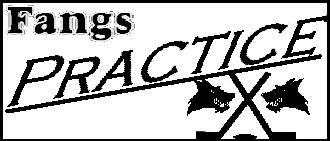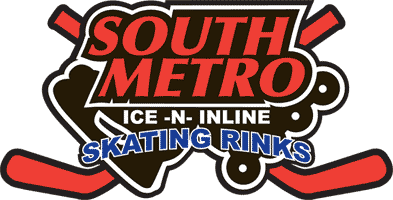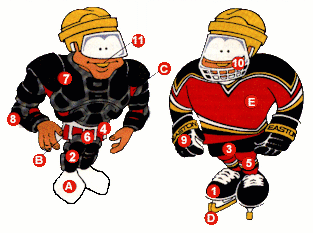News and Announcements


Players who do not have their own equipment have several options.
Borrowing equipment from others will likely be the cheapest option. However, there may not be enough people who have enough equipment in the right sizes. You should still look at purchasing your own helmet and skates. The price of skates will vary depending on quality, size, and company. With skates you really get what you pay for! If you in it for the long haul......i would consider this an investment and GO BIG!. The more you pay the more comfortable and durable the skates will be, with better protection and better responsive to your control! For skate sizing: Dont buy online!....go try them on, all brands size different, mens vs womens, and personal preference. I suggest for helmet sizing, no matter where you purchase your helmet, you should go to play it again and try a few on to see what fits best. If you need help with your equipment purchase please contact info@daytonfangs.com
Buying used equipment from play it again sports. This is a great way to get started. They generally have good deals on equipment and will make you deals if you are purchasing alot. This will keep your costs much lower, in most cases.
Buying new or used from Ebay. There is always some risk purchasing from ebay.
Buying from websites like hockeyworld, hockeygiant, hockeymonkey, Total Hockey, etc.
To the Right is a picture of the equipment you'll need:
Hockey Helmet with face mask (or shield) $35-150.
Hockey Skates $150-800.
Hockey Shin guards (depending on your height most women wear between (12"-15) $35-100
Hockey Pants $30-150
Hockey Pelvic Protector (Jill) $30-80
Garter Belt (some pelvic protectors already have this) $5-7
Shoulder Pads $30-150
Elbow Pads $35-90
Neck protector/Throat Gaurd $7-15
Mouth Guard $5-100 (custom dental guards are $$, but very nice)
Hockey Gloves $20-100 (Women usually wear size 13-15)
Hockey Stick $20-300
Hockey Tape $3-5
Hockey Bag $20-100
To get started it will probably cost you around $250-1000+ depending on quality and new vs used. If you purchase everything from one place they will usually give you a discount. ASK, it won't hurt to ask.
I've also see used equipment sets on ebay go for less than $40, so keep your eye out.
Hockey is an expensive sport. However, making certain choices you can lessen the expense.
Playing is completely worth it. The exercise you get is amazing and the friendships can be lifelong.
If you think about it, it cost less than joining most gyms, and you actually want to go. You'll also have more excitement than 20 minutes on a eliptical machine will ever give you!
Hockey Equipment and Skates Fitting Guide
All sizing is approximate.
GOALIE
Goalie Mask Fitting Guide
It is recommended that all goaltenders wear CSA and HECC certified masks. All CSA and HECC certified masks have a sticker indicating their certification.
When fitting the Profile goaltender mask, adjust the unit so that the upper perimeter of the frontal component is 1/4" above the eye-brow. For a proper fit, make sure all straps are fastened so that the chin cup fits snugly against the chin and the mask achieves a snug fit.
Goalie Arm and Body Protector Fitting Guide
One of the most important consideration for the chest pad is length. In general, the bottom of the chest pad should meet or slightly overlap the top of the protective cup when the goaltender is in a crouched position. The shoulders should fit directly under the large caps of the pad, and the elbows should be centered in the elbow cap to provide maximum protection.
Measure the player's chest just below the arm pits. Refer to the sizing chart below to determine the corresponding size.
ARM AND BODY PROTECTOR SIZING
Size Chest Size
Youth - M, L, X-Large up to 28"
Junior - Medium 28" - 32"
Junior - Large 32" - 36"
Junior - X-Large 36" - 40"
Intermediate - Medium 26" - 30"
Intermediate - Large 30" - 34"
Intermediate - X-Large 34" - 38"
Senior - Small 34" - 38"
Senior - Medium 38" - 42"
Senior - Large 42" - 46"
Senior - X-Large 46"+
Goalie Blocker and Catcher Fitting Guide
The palm and the fingers of both goalie catchers and blockers should fit like loose winter gloves. Arm pads should fit under the cuffs of both the blocker and catcher (approximately 2-3 inches under) without inhibiting flexibility.
Catchers and blockers should offer freedom of movement without chafing or restricting movement.
Goalie Pad Fitting Guide
The key factor here is the overall length. The length can be divided into three sections.
1) The boot, 2) Instep to knee, and 3) Knee to top or thigh rise. The proper length of the goal pad boot is determined by the goalie's skate size. The next key area is the instep to knee that determines the shin length. Finally, the knee to top or thigh rise is a personal measurement depending on how much pant and pad overlap the goaltender prefers. A general rule is 7" to 8"
A. Instep to Knee:
Measure from instep to the front center of kneecap while leg is in slightly bent position.
B. ThighRise:
Measure from front center of kneecap up the thigh to desired height.
C. Skate Size:
Provide the skate size for proper boot fit.
A + B + C = estimated size of pad
If fitted properly, the goalie's knee should rest directly behind the center knee roll with the pad securely attached to the goal skate and properly strapped on the goaltender's leg. Generally, this will ensure that the pad breaks (bends) at the knee/shin and ankle as designed for optimal performance.
There may be slight differences between manufacturer's sizing.
PLAYER
Hockey Skates Fitting Guide
Sewn ice hockey skates generally fit 1 to 1 1/2 sizes down from your regular shoe size.
While sitting down, and wearing the socks that will be worn while skating, the skater should put the skate on and kick his heel back into the skate. The toes should barely touch the toe cap. Lacing the boot up, the heel should be continuously kicked back to ensure a tight fit.
When finished lacing, get up and walk around for 10-15 minutes so you get the proper fit and feel of the hockey skates. The foot should feel comfortable with the rear snug and resting on the footbed. The toes should be extended flat and be able to just feather the toe cap.
When fitting children, follow the above steps, allowing 1/2 size extra for growth. Anything over the recommended 1/2 size could result in premature breakdown of the skate. (1/2" room would be equivalent to one finger between heel and back of skate.)
Hockey Helmets Fitting Guide
Protection
A hockey helmet should fit snug to prevent any shifting and maximize protection. Make sure the chinstrap can be adjusted so it gently makes contact under the chin when fastened. Hockey rules may require that you wear CSA and HECC certified helmets. Check the rules by which you play for the requirements. All CSA and HECC certified helmets have a sticker indicating their certification.
Comfort / Fit
To adjust your helmet properly, open to it's largest setting and gradually begin to downsize the helmet until a comfortably snug fit is achieved. The helmet should rest on the head so that the rim is one finger width above the eyebrow and making contact with the top of your head.
The hat size is included with each of our helmets on the ordering pages to give you a guideline to follow from each manufacturer.
Adult & Over – 14 years 6 7/8" to 7 3/4"
Intermediate – 8 to 14 years 6 3/8" to 7 1/4"
Junior – 5 to 8 years 6 1/4" to 6 7/8"
Youth – 2 to 5 years 6" to 6 1/2"
HEAD CIRCUMFERENCE AND HAT SIZES
Circumference Hat Size
20 1/8", 20 1/2", 20 7/8" 6 3/8", 6 1/2", 6 5/8"
21 1/4", 21 5/8", 22" 6 3/4", 6 7/8, 7"
22 3/8", 22 3/4", 23 1/8" 7 1/8", 7 1/4", 7 3/8"
23 1/2", 23 7/8", 24 1/4" 7 1/2", 7 5/8", 7 3/4"
24 5/8", 25" 7 7/8", 8"
Hockey Player Face Masks Fitting Guide
The hockey face mask should fit snugly to the chin. If it is too long, it may come into contact with the nose and mouth during impact. When the player's mouth is closed, the chin should fit comfortably into the chin cup. Attach the face mask securely to the hockey helmet according to instructions provided within the product packaging.
It is recommended that the player wear CSA, CE, and HECC certified facial, All CSA, CE and HECC certified facial have stickers indicating their certification.
Hockey Shoulder Pads Fitting Guide
Junior Size Senior Size
L 28" to 30" XL 42" to 44"
M 24" to 28" L 40" to 42"
Youth Size M 36" to 38"
20'" to 24" S 32" to 34"
Measure the player's chest just below the arm pits. Refer to the sizing chart to determine the corresponding shoulder pad size.
The center of the player's shoulder should line up directly with the center of the shoulder caps. Good hockey shoulder pad fit should provide protection for the chest, ribs, back, collar bone, and upper arms. A player should have good range of motion while wearing shoulder pads. To test range of motion, lift arms above shoulder height to ensure the pads do not dig into the neck.
Hockey Elbow Pads Fitting Guide
The top of the elbow pad should meet the bottom of the arm of the shoulder pad and extend down the forearm to the top of the glove. The elbow pad should not restrict movement of the elbow. With the elbow pads on, test the range of motion by bending the arm at the elbow, watching for restriction.
Hockey Gloves Fitting Guide
Hockey gloves should generally fit like loose winter gloves over the fingers. The top of the glove needs to extend up to the forearm to the bottom of the elbow pads (except short cuff fit). The main consideration with the fit of a hockey glove, is that the gap between the glove and the elbow pad is minimal.
The glove should offer freedom of movement in all positions without chafing or restricting movement. Measure the distance between the fingertips and the elbow pad to determine the hockey glove size
HOCKEY GLOVE SIZING
Senior 14", 15"
Intermediate 13"
Junior 11", 12"
Youth 8" , 9", 10"
Hockey Pants Fitting Guide
Senior Waist Size Junior Waist Size
S 30" to 32" S 24" to 26"
M 32" to 34" M 26" to 28"
L 34" to 36" L 28" to 30"
XL 36" to 38"
XXL 38" to 40"
Hockey players should have a good range of motion while wearing hockey pants. The bottom of the pants should overlap the top of the hockey shin guard kneecaps by 1 or 2 inches. If the player can comfortably squat and the padding remains in position, then the pants fit properly.
Hockey Shin Guards Fitting Guide
Ensure that the cap of the shin pad is centered on the knee cap. The calf padding should wrap around the lower leg. Measure from the center of the knee cap to the top of the skate boot. Match the player's shin size to the inches of the shin guards.
Hockey Sticks Fitting Guide
Stand in your stocking feet and place the toe of your stick on a level surface between your feet. A general rule of thumb is to mark and cut the handle of your stick where it touches the tip of your nose. When standing with your skates on, the stick should come up to your chin or just below it.
Next is Flex.....
Flex is important, its how you get power out of the stick. To much flex and you won tbe able to bend it to get any pop. Most women should use a stick with a flex less then 80. Either Adult of Intemediate size. Int. has a thinner shaft and is ideal for petite hands!
